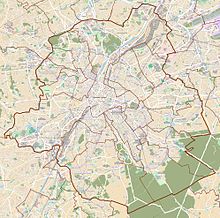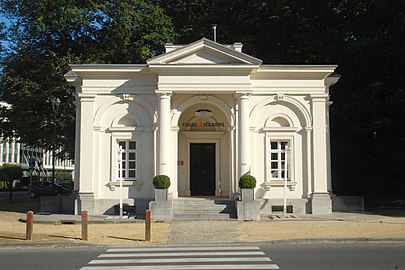Avenue Louise
 The Avenue Louise/Louizalaan in winter | |
 Location within Brussels | |
| Location | City of Brussels, Brussels-Capital Region, Belgium |
|---|---|
| Coordinates | 50°49′37″N 04°21′52″E / 50.82694°N 4.36444°ECoordinates: 50°49′37″N 04°21′52″E / 50.82694°N 4.36444°E |
The Avenue Louise (French) or Louizalaan (Dutch) is a major thoroughfare in Brussels, Belgium. It is named in honour of King Leopold II's eldest daughter, Princess Louise (1858–1924).
The Avenue Louise runs southeast from the to the Bois de la Cambre/Ter Kamerenbos, covering a distance of 2.7 km (1.7 mi). It is one of the most prestigious and expensive avenues in Brussels, however at night it becomes an area of prostitution.[1][2][3] It is served by the metro station Louise/Louiza (on lines 2 and 6), as well as the tramway lines 8 and 93, which run its entire length.
History[]
Construction[]
The construction of the Avenue Louise was commissioned in 1847 as a monumental avenue bordered by chestnut trees that would allow easy access from Brussels' city centre to the popular recreational area of the Bois de la Cambre/Ter Kamerenbos. It was also to be the first Haussmann-esque artery of the city. Its name was chosen in honour of King Leopold II's eldest daughter, Princess Louise, as is the Place Louise/Louizaplein, a major square located in its upper part. The Place Stéphanie/Stefanieplein, another square on the avenue, is named in honour of her younger sister, Princess Stéphanie.

Originally, fierce resistance to the project was put up by the town of Ixelles—then, as now, a separate municipality (local authority) from the City of Brussels—through whose territory the avenue was to run. After years of fruitless negotiations, Brussels finally annexed the narrow band of land needed for the avenue, plus the Bois de la Cambre itself, in 1864. That decision accounts for the unusual shape of today's City of Brussels and for Ixelles being split into two separate parts.
Gestapo headquarters[]

During World War II, following the German invasion of Belgium, Brussels was occupied by the German military. The Nazi security organisation, the Sicherheitspolizei-Sicherheitsdienst (Sipo-SD), of which the Gestapo was a part, set up their Brussels headquarters on the Avenue Louise.[4] They occupied numbers 347, 418, 453 and 510;[4] initially their headquarters were at number 453, in the Résidence Belvédère.[5]
On 20 January 1943, Baron Jean de Sélys Longchamps, a Brussels-born fighter pilot in the Royal Air Force, mounted a solo attack on the headquarters at number 453.[6] Benefiting from the wide avenues, and the large height of the apartment block relative to the neighbouring buildings, he flew his Hawker Typhoon at a low altitude straight towards the building, firing the plane's 20 mm cannons, before returning to England.[6] Following this attack, the SD moved their headquarters to number 347, Avenue Louise.[4] The cellars at this address were used to detain and interrogate captured members of the Belgian resistance.[7] The torture which took place there brought the Avenue Louise's name considerable infamy at the time.[8] A monument to Baron de Selys Longchamps now stands in front of 453, Avenue Louise.[9]
Landmarks[]
The Avenue Louise is home to many upmarket shops, restaurants and offices. From north to south, notable landmarks include:
- the Place Louise/Louizaplein, a crucial transportation nexus, including a tramway and metro station. The Law Courts of Brussels are located nearby.
- the Place Stéphanie/Stefanieplein, another extremely busy square surrounded by luxury shops. The tree-bordered part of the avenue begins there.
- the Louise Tower, also known as the Generali Tower, one of the tallest office buildings in Brussels.
- the intersection with the Chaussée de Vleurgat/Vleurgatsteenweg (which leads downhill to the nearby Place Eugène Flagey/Eugène Flageyplein) dominated by the Blue Tower (1976) by Henri Montois.
- the scenic King's Garden (French: Jardin du Roi, Dutch: Hof van de Koning), a garden descending toward the nearby Ixelles Ponds.
- Olivier Strebelle's 16-tonne bronze sculpture Le Phénix 44 commemorating the anniversary of the liberation of Brussels, which stands athwart the roundabout at the King's Garden.
- the Carrefour de Sélys Longchamps/De Sélis Longchampskruispunt, which features several statues, the entrance to La Cambre Abbey, and the massive IT Tower.
- a roundabout flanked by two twin neoclassical former toll pavilions ending the avenue. Beyond it lies the Bois de la Cambre/Ter Kamerenbos.
- the nearby Pro-Cathedral of the Holy Trinity, part of the Church of England.

Blue Tower (Montois, 1976)

Entrance of the Square du Bois, Avenue Louise 535–587

Le Phénix 44 (Strebelle, 1994)
Former toll pavilion at the entrance of the Bois de la Cambre/Ter Kamerenbos
The "Louise bottleneck"[]
The 250-metre-long (820 ft) part of the Avenue Louise between the Place Louise/Louizaplein and the Place Stéphanie/Stefanieplein is called le goulet Louise in French ("the Louise bottleneck"). With two tramway lines and thousands of cars sharing this narrow segment of the avenue, large traffic jams occur there during rush hours. The problem was already obvious in the early 1980s, so a tram tunnel under the bottleneck was built along with the metro station on the Place Louise. However, construction was abandoned toward its end due to protests of local businesses fearing losses if patrons were to be diverted through a tunnel.[10]
The nearly-completed, vast tramway tunnel under the Louise bottleneck remains unused as of 2009. Various solutions to the traffic problem have been considered. One proposes pedestrianising the whole segment, with trams running on the surface and only delivery vehicles authorised at certain hours. Another, much more costly, involves finishing the tunnel and diverting all trams underground.
Tramway lines 8 and 93 runs the entire length of the avenue, all on segregated track except in the short "goulet Louise" section.
Embassies[]
The Avenue Louise houses many embassies, including those of:
- No. 130: Dominican Republic
- No. 176: Bolivia
- No. 181: Montenegro
- No. 225: Argentina
- No. 250: Bahrain
- No. 350: Brazil
- No. 363: Ecuador
- No. 379: Suriname
- No. 425: Croatia
- No. 475: Paraguay
- No. 489: Costa Rica
Representative Offices[]
- No. 284/286: Northern Cyprus
See also[]
| Wikimedia Commons has media related to Avenue Louise/Louizalaan. |
References[]
- ^ Helm, Sarah (26 November 1996). "Gays under pressure in Belgium's moral backlash Anger over child". The Independent. Retrieved 1 February 2019.
- ^ "Brussels bans prostitution again in bid to curb Covid-19 infection rate". www.thebulletin.be. 29 September 2020. Retrieved 11 September 2021.
- ^ "Council of State overturns Brussels prostitution ban". The Brussels Times. 14 October 2020. Retrieved 11 September 2021.
- ^ Jump up to: a b c "Avenue Louise 347 Louizalaan" (in French). Retrieved 2009-02-04.
- ^ "Résidence Belvédère Avenue Louise 453" (in French). Retrieved 2009-02-09.[dead link]
- ^ Jump up to: a b "Baron Jean De Selys Longchamps". Archived from the original on 29 December 2008. Retrieved 2009-02-04.
- ^ "Les Territoires de la Mémoire: Triangle rouge: visite" (in French). Archived from the original on December 14, 2007. Retrieved 4 February 2009.
- ^ "Westminster College Welcomes Veterans Day "Speaker of Freedom"". Archived from the original on 4 June 2011. Retrieved 4 February 2009.
She was moved to several prisons including '347 Avenue Louise,' Gestapo torture headquarters, where she was interrogated and tortured with beatings and experiments.
- ^ "Former Gestapo Headquarters - 453 Avenue Louise". Retrieved 4 February 2009.
- ^ La saga du goulet Louise - EuroBRU.com - Retrieved 12 July 2007.
Bibliography[]
- Duquenne, Xavier (2007). L'avenue Louise à Bruxelles (in French). Brussels: Self-published. ISBN 2-87126-039-7.
- Francis, Jean (1975). La Chanson des rues d'Ixelles (in French). Brussels: Louis Musin Éditeur. p. 118.
External links[]
- "(Avenue Louise)" – via Europeana. (Images, etc.)
- History and architecture of Avenue Louise (St Gilles) - on the irismonument site - l'inventaire du patrimoine architectural de la Région de Bruxelles-Capitale
- History and architecture of Avenue Louise (Brussels southern extension) - on the irismonument site -l'inventaire du patrimoine architectural de la Région de Bruxelles-Capitale
- Streets in Brussels
- Shopping districts and streets in Belgium
- City of Brussels
- Neighbourhoods of Brussels




